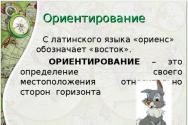Rectilinear uniformly accelerated motion. Presentation on the topic "Movement of a body during rectilinear uniformly accelerated motion without initial speed (along the x axis)" Presentation on the topic displacement during uniformly accelerated motion
Agreement
Rules for registering users on the website "QUALITY MARK":
It is prohibited to register users with nicknames similar to: 111111, 123456, ytsukenb, lox, etc.;
It is prohibited to re-register on the site (create duplicate accounts);
It is prohibited to use other people's data;
It is prohibited to use other people's e-mail addresses;
Rules of conduct on the site, forum and in comments:
1.2. Publication of personal data of other users in the profile.
1.3. Any destructive actions in relation to this resource (destructive scripts, password guessing, violation of the security system, etc.).
1.4. Using obscene words and expressions as a nickname; expressions that violate the laws of the Russian Federation, ethical and moral standards; words and phrases similar to the nicknames of the administration and moderators.
4. Violations of the 2nd category: Punishable by a complete ban on sending any types of messages for up to 7 days. 4.1. Posting information that falls under the Criminal Code of the Russian Federation, the Administrative Code of the Russian Federation and is contrary to the Constitution of the Russian Federation.
4.2. Propaganda in any form of extremism, violence, cruelty, fascism, Nazism, terrorism, racism; inciting interethnic, interreligious and social hatred.
4.3. Incorrect discussion of work and insults to the authors of texts and notes published on the pages of the "SIGN OF QUALITY".
4.4. Threats against forum participants.
4.5. Posting deliberately false information, slander and other information discrediting the honor and dignity of both users and other people.
4.6. Pornography in avatars, messages and quotes, as well as links to pornographic images and resources.
4.7. Open discussion of the actions of the administration and moderators.
4.8. Public discussion and assessment of current rules in any form.
5.1. Swearing and profanity.
5.2. Provocations (personal attacks, personal discredit, formation of a negative emotional reaction) and bullying of discussion participants (systematic use of provocations in relation to one or more participants).
5.3. Provoking users to conflict with each other.
5.4. Rudeness and rudeness towards interlocutors.
5.5. Getting personal and clarifying personal relationships on forum threads.
5.6. Flooding (identical or meaningless messages).
5.7. Intentionally misspelling nicknames and names of other users in an offensive manner.
5.8. Editing of quoted messages, distorting their meaning.
5.9. Publication of personal correspondence without the express consent of the interlocutor.
5.11. Destructive trolling is the purposeful transformation of a discussion into a skirmish.
6.1. Overquoting (excessive quoting) of messages.
6.2. Use of a red font intended for corrections and comments by moderators.
6.3. Continuation of discussion of topics closed by a moderator or administrator.
6.4. Creating topics that do not carry semantic content or are provocative in content.
6.5. Creating the title of a topic or message in whole or in part in capital letters or in a foreign language. An exception is made for titles of permanent topics and topics opened by moderators.
6.6. Create a signature in a font larger than the post font, and use more than one palette color in the signature.
7. Sanctions applied to violators of the Forum Rules
7.1. Temporary or permanent ban on access to the Forum.
7.4. Deleting an account.
7.5. IP blocking.
8. Notes
8.1. Sanctions may be applied by moderators and administration without explanation.
8.2. Changes may be made to these rules, which will be communicated to all site participants.
8.3. Users are prohibited from using clones during the period of time when the main nickname is blocked. In this case, the clone is blocked indefinitely, and the main nickname will receive an additional day.
8.4 A message containing obscene language can be edited by a moderator or administrator.
9. Administration The administration of the site "SIGN OF QUALITY" reserves the right to delete any messages and topics without explanation. The site administration reserves the right to edit messages and the user's profile if the information in them only partially violates the forum rules. These powers apply to moderators and administrators. The administration reserves the right to change or supplement these Rules as necessary. Ignorance of the rules does not relieve the user from responsibility for violating them. The site administration is not able to verify all information published by users. All messages reflect only the opinion of the author and cannot be used to evaluate the opinions of all forum participants as a whole. Messages from site employees and moderators are an expression of their personal opinions and may not coincide with the opinions of the editors and management of the site.
Physics 9th grade
summary of other presentations“Magnetic field grade 9” - The figure shows a section of such a conductor located perpendicular to the plane of the drawing. Uniform and non-uniform magnetic field. Such a field is called inhomogeneous. Let's consider the picture of the magnetic field lines of a permanent strip magnet shown in the figure. Municipal educational institution "Kurzhinskaya basic secondary school" Physics teacher - Repnikov Ivan. Valerievich, 2008.
“Lesson on the Law of Universal Gravitation” - Cavendish (English) - first! Why? History of discovery. N. Copernicus. I. Kepler. F21. Does not depend on r. Not applicable. Torsion scales: F12. Quiet Brahe. Present the found material as a web page on the school website. 1 kg. Therefore, the purpose of the lesson: Therefore F~m1m2. Limits of applicability. "At the tip of the pen." 23+9 I. Newton 1667.
“Physics in everyday life” - Ordinary Latch. Electric valve. Moscow 2011. 1) Power supply. Physics in everyday life. Electric motor. Technical diagram. Details. Competition "Smart Men and Women". Key. Plastic moving part. Home experiments! Electrical diagram. Electric motor. General view of the system. Running wheel. Work of 9th grade student Danyushkina A. Supervisor Lashkareva L.D. Contents: Electrical diagram General view of the system Details.
“Dispersion of light physics” - Monocle. Do eye exercises. Dispersion of light. 9th grade Ryzhkova T.P. Physics teacher, Secondary School No. 10. Scattering, Collecting. S P E K T R spectrum (Latin) - introduction. Thus, the computer is the most dangerous source of electromagnetic radiation. The image in a diverging lens is always... Physical dictation “Continue the sentence.” The optical power of a system of closely spaced lenses is…. Use an LCD monitor. From the history of optics, or Just glasses. Dispersion is the phenomenon of decomposition of white light into a spectrum.
“Lomonosov’s Mathematics” - Lomonosov and mathematics. Presentation of a message by a student of class 9 “B” Kislova Alexandra St. Petersburg, 2011. Chemistry and mathematics! Discovered the presence of an atmosphere on the planet Venus. Lomonosov attached great importance to mathematics, recommending the widespread use of mathematical methods in other sciences. Elementa Chimiae Mathematicae.
“M.V. Lomonosov” - Lomonosov presented his observations and discoveries in a brilliant, publicly accessible form. How and where does the ode begin? Lomonosov is the author of “Russian Grammar” (1755). First steps in his studies... Lomonosov married abroad, in 1740, in Marburg, to Elisabeth Zilch. Lomonosov is a poet. Arkhangelsk Drama Theatre. What does Lomonosov glorify in the ode?

Uniformly accelerated motion is a motion in which the speed of a body changes equally over equal periods of time.
Acceleration is a quantity equal to the ratio of the change in speed to the period of time during which this change occurred.


S x

S x


Task No. 1. With what acceleration does a racing car move if its speed increases from 144 to 216 km/h in 6 s?
Problem No. 2 How long will it take the rocket to reach its first escape velocity of 7.9 km/s if it moves with an acceleration of 50 m/s 2 ?
Task No. 3 Calculate the length of the runway if the plane's speed is 300 km/h and the acceleration time is 40 s.
Task No. 4
The speed of the racing car at the start of acceleration is 10 m/s, acceleration 5 m/s 2 . Determine the distance traveled by the car in 10 s after the start of movement. What is the speed of the car at the end of the tenth second of acceleration?
Problem No. 5 The braking distance of a car moving at a speed of 50 km/h is 10 m. What is the braking distance of the same car at a speed of 100 km/h?
Problem No. 6 What is the length of the plane's run when landing if its landing speed is 140 km/h and the acceleration during braking is 2 m/s 2 ?
Problem No. 7 With uniformly accelerated motion with an initial speed of 5 m/s, the body traveled 20 m in 3 s. With what acceleration did the body move? What is its speed at the end of the third second?

1.What types of movement do you know? 2. Define each of them. 3.What quantities characterize these types of movement? 4.What is the acceleration of uniformly accelerated motion called? 5.What is uniformly accelerated motion? 6.What does the acceleration module show? 7. The train leaves the station. What is the direction of its acceleration? 8. The train begins to slow down. What are the directions of its speed and acceleration? Frontal survey Think and answer!
Vxvx t vxvx -vx-vx 2 1 Characterize the movements of material points whose v x (t) graphs (1 and 2) are presented in the figure. How to determine from these graphs the projection of the displacement of a point on the x-axis, its module and the distance traveled? 1. A O SxSx SxSx Solve orally Fig. 1

Solve t O orally. Figure 2 schematically shows graphs of the speed of bodies versus time. What do these movements have in common and how do they differ? vxvx Fig. 2

Decide orally which part of the graph of speed versus time (Fig. 3) corresponds to uniform motion, uniformly accelerated with increasing speed, uniformly accelerated with decreasing speed? vxvx A B C D t O vxvx vxvx Fig. 3

Figure 4 schematically shows graphs of the speed of bodies versus time. What do all movements have in common and how do they differ? vxvx t O A t Solve orally Fig. 4

Graph of the projection of the velocity vector of a body moving with constant acceleration t vxvx v ox axtaxt D C M B O Fig. 14 (b), page 29 (Peryshkin A.V. “Physics-9”) D B The area under the velocity graph is numerically equal to the displacement. Therefore, the area of the trapezoid is numerically equal to the displacement. Graph of the projection of the velocity vector of a body moving with constant acceleration Fig. 5






X0x0 x x t t 0 Remember! ! x0x0 -x0-x0 a x >0a x 0a x "> 0a x "> 0a x " title="x0x0 x x t t 0 Remember! ! x0x0 -x0-x0 a x >0a x"> title="x0x0 x x t t 0 Remember! ! x0x0 -x0-x0 a x >0a x"> !}
Problems (at the board) The kinematic law of train motion along the Ox axis has the form: x = 0.2t 2. Is the train accelerating or decelerating? Determine the initial velocity projection and acceleration. Write down the equation for the projection of velocity onto the Ox axis. Graph the projections of acceleration and velocity. 8. The position of a soccer ball rolling along the Ox axis along the field is given by the equation x=10 + 5t – 0.2t 2. Determine the projection of the initial velocity and acceleration. What is the coordinate of the ball and the projection of its speed at the end of the 5th second? 9.

Uniformly accelerated motion Physical quantity Graph Velocity Acceleration Displacement Coordinate B A C DE FGH Think and find the correspondence x Fig. 10


Thanks for the work! Homework § 7-8, page Exercise 7 (1), ex. 8 (2) (Peryshkin A.V., Gutnik E.M. Physics. 9th grade. - M.: Bustard, 2007). Thank you for the lesson!








